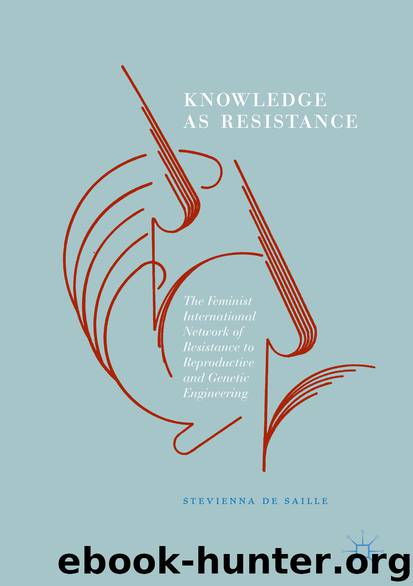Knowledge as Resistance by Stevienna de Saille

Author:Stevienna de Saille
Language: eng
Format: epub
Publisher: Palgrave Macmillan UK, London
As a member of the Shakti Collective in Bombay, Patel had also helped publish a collection of papers from a workshop, ‘Feminist Perspective on Women and Health: Reproduction in India’, convened precisely for the purpose of developing a women’s health movement not dictated by Western understandings, but responsive to the particular contexts of India (Bhate et al. 1987). Using a methodology similar to Hanmer’s early work, Patel’s (1987, 73) close reading of Indian medical papers showed that many Indian doctors believed the use of amniocentesis for sex selection was an effective method of birth control, as it meant fewer females overall would be born. Similarly, in the preface of a 75-page dossier of news clippings compiled and published after Comilla, Lakshmi Lingam had noted that there was a ‘slow importing of NRTs which are whipping up strong patriarchal anti-women attitudes by predominantly viewing women as “mothers” and “objects” for experimentation’ (Lingam 1990, 9). One of these excerpts quoted Dr. Anand Kumar , then India’s leading IVF doctor, as saying that one of the ‘many opportunities’ IVF provided was learning ‘how to induce infertility in fertile couples as a means to family planning’ (Times of India, 13 August 1997, in Lingam 1990, 3, emphasis mine).39
Overall, however, despite the strong emphasis on connecting technologies for confirming the status of a pregnancy with those for preventing and creating it, the Indian women’s movement does not appear to have taken up IVF as an issue at this time. Surveying a number of women from different grassroots Indian organisations 15 years later, Sama , an autonomous women’s health research group in Delhi, found that many of the activists still did not feel that conceptive technologies like IVF were an appropriate site for intervention as they affected only a small, rich, urban sector of the population and could not be used without consent, whereas contraceptives affected 90% of the population and were frequently forced upon women without information or agreement (Sama 2006).40 Politics within the global women’s health movement were also moving towards the opposite stance, towards seeing NRT as allowing women to take control of their lives and overcome the circumstances they had been dealt, whether this was extreme poverty or the inability to have a child. The Women’s Global Network on Reproductive Rights (WGNRR) had now grown from the 1984 Amsterdam conference into an umbrella network of organisations, networks and individuals and had also gone through a period of struggle over its ‘position’ in the late 1980s, before establishing itself as a donor-funded NGO with self-determination as its ‘basic cornerstone’(WGNRR 2014).41 It was precisely this framing of reproductive ‘rights’ which Akhter had sought to problematise at the opening plenary in Comilla in 1989 , by emphasising that FINRRAGE had a ‘distinctive philosophical position’ and that the conference had a ‘transformative’ intent (see Akhter 2005, 67–74).
In May 1990, an UBINIG-FINRRAGE regional follow-up meeting was held at BARD in Comilla, in the same agricultural college where the international conference had taken place the year before. By
Download
This site does not store any files on its server. We only index and link to content provided by other sites. Please contact the content providers to delete copyright contents if any and email us, we'll remove relevant links or contents immediately.
| Administration & Medicine Economics | Allied Health Professions |
| Basic Sciences | Dentistry |
| History | Medical Informatics |
| Medicine | Nursing |
| Pharmacology | Psychology |
| Research | Veterinary Medicine |
Tuesdays with Morrie by Mitch Albom(4692)
Yoga Anatomy by Kaminoff Leslie(4306)
Science and Development of Muscle Hypertrophy by Brad Schoenfeld(4089)
Bodyweight Strength Training: 12 Weeks to Build Muscle and Burn Fat by Jay Cardiello(3915)
Introduction to Kinesiology by Shirl J. Hoffman(3725)
How Music Works by David Byrne(3187)
Sapiens and Homo Deus by Yuval Noah Harari(2987)
The Plant Paradox by Dr. Steven R. Gundry M.D(2547)
Churchill by Paul Johnson(2506)
Insomniac City by Bill Hayes(2498)
Coroner's Journal by Louis Cataldie(2432)
Hashimoto's Protocol by Izabella Wentz PharmD(2331)
The Chimp Paradox by Peters Dr Steve(2297)
The Universe Inside You by Brian Clegg(2097)
Don't Look Behind You by Lois Duncan(2080)
The Immune System Recovery Plan by Susan Blum(2028)
The Hot Zone by Richard Preston(1983)
Endure by Alex Hutchinson(1964)
Woman: An Intimate Geography by Natalie Angier(1882)
